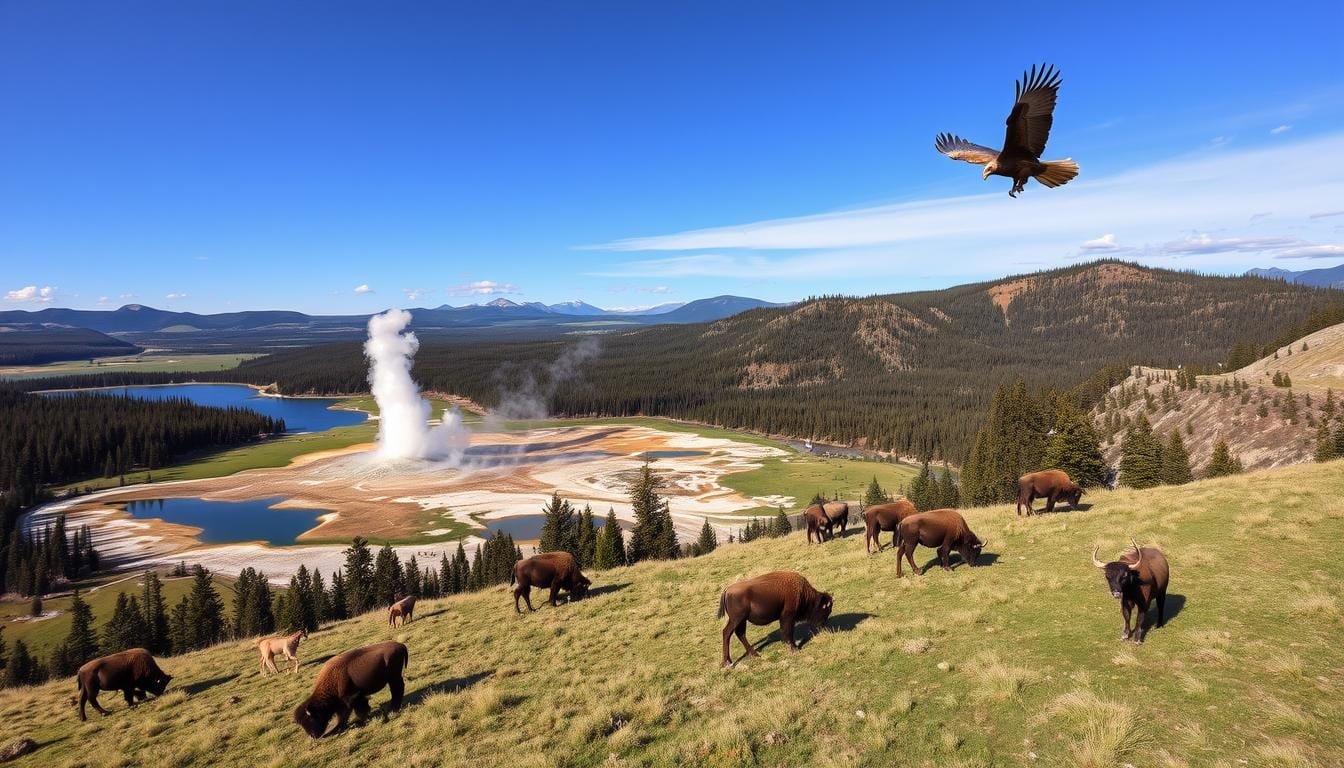The USA has many amazing places to see wildlife. You can find everything from big national parks to secret nature spots. These places are full of different animals and plants.
Yellowstone National Park is a top spot for wildlife. It covers over 3,000 square miles. Here, you can see animals like bison, moose, elk, and bears in the wild.
But remember, stay safe. Keep at least 100 yards away from bears or wolves. For other animals, it’s okay to be 25 yards away.
Kenai Fjords National Park in Alaska is great for seeing marine life. You can see whales, seals, and sea otters here. The Everglades in Florida is also special. It’s home to alligators, manatees, and the rare Florida panther.
Places like the Monarch Butterfly Reserve in Mexico are amazing in winter. They have millions of monarch butterflies. For something different, try falconry in Vermont or shark diving in Hawaii.
Big Bend National Park in the desert and Assateague Island by the sea are both unique. They offer amazing chances to see wildlife up close.
Top National Parks for Wildlife Encounters

America’s national parks are great for seeing wildlife in their homes. They have wilderness areas and scenic trails. These parks are perfect for bird watching and taking photos of wildlife.
Yellowstone: America’s Premier Wildlife Haven
Yellowstone National Park is a wildlife paradise. It has nearly 70 species of mammals. You can see bison, wolves, and grizzly bears here.
Grand Canyon’s Desert Wildlife Experience
The Grand Canyon is special for desert wildlife. You can see bighorn sheep and California condors here. The park’s ecosystems support many animals that live in harsh conditions.
Everglades: Tropical Wildlife Paradise
Florida’s Everglades National Park is a tropical paradise. It has over 40 mammal species, like white-tailed deer and marsh rabbits. The wetlands are great for spotting alligators and birds.
Rocky Mountain National Park’s Alpine Animals
Rocky Mountain National Park is home to alpine wildlife. It has 67 mammal species, including pikas, marmots, and elk. The scenic trails are perfect for wildlife photos against stunning mountains.
| National Park | Number of Wildlife Species | Notable Animals |
|---|---|---|
| Yellowstone | 70 | Bison, Wolves, Grizzly Bears |
| Everglades | 40+ | Alligators, White-tailed Deer, Marsh Rabbits |
| Rocky Mountain | 67 | Pikas, Marmots, Elk |
Ultimate USA Wildlife Spot Destinations
The USA is full of places great for seeing wildlife. The National Wildlife Refuge system covers 150 million acres. It protects over 220 mammals and 700 birds.
Yellowstone is America’s first national park. It’s called ‘America’s Serengeti’. Lamar Valley is full of bison, bears, and wolves.
Monterey Bay in California is great for whale watching. You can see grey whales, humpbacks, and sea otters. Alaska’s Frederick Sound has lots of humpback whales, perfect for photos.
Theodore Roosevelt National Park in North Dakota has many trails. You can hike or ride horses and see different animals. The park has three parts with different views and animals.
- Assateague Island: Famous for wild horses
- Crystal River, Florida: Manatee encounters
- Channel Islands, California: ‘Galapagos of North America’
- Katmai, Alaska: Prime bear-watching location
These places show the USA’s wide range of wildlife. From the coast to mountains, they offer great chances to see animals. They are must-see places for nature lovers.
Conclusion
The USA is full of amazing places to see wildlife. You can find these spots in many different landscapes. Yellowstone National Park is a top place to see animals like bison and wolves.
Bosque Del Apache National Wildlife Refuge is another great spot. It’s not as well-known but still has lots of wildlife. Yellowstone’s Lamar Valley is especially good for seeing animals.
Katmai National Park in Alaska is famous for bear watching. The Everglades in Florida is great for bird lovers. The Grand Canyon and Rocky Mountain National Park offer unique experiences.
These parks are not just for fun. They also help protect wildlife. When you visit, try to go in spring for birds or fall for elk.
Always keep a safe distance from animals. Also, help local conservation efforts. This way, your visit can be both fun and meaningful.



